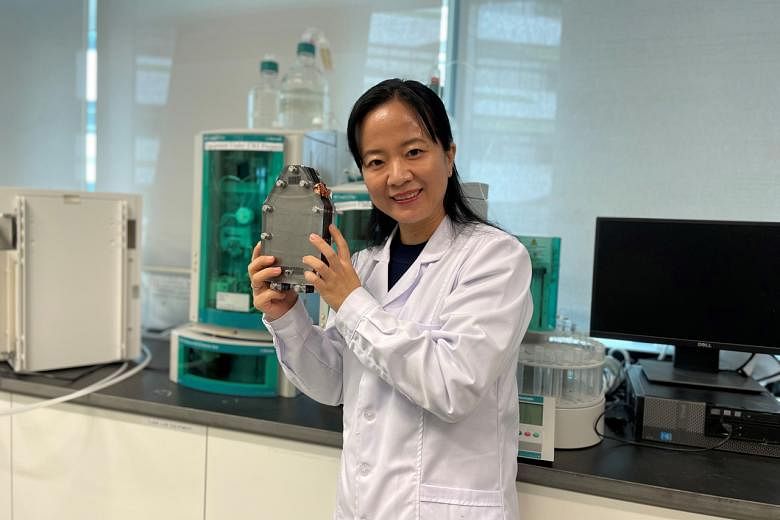SINGAPORE - The Republic has long considered the surrounding seas as a resource that can be converted into drinking water. But new research has shown the potential of the process as an energy source too.
A team from the Singapore University of Technology and Design (SUTD) is working on developing a "desalination battery".
This new technology aims to harness energy through the desalination process, which entails the removal of salts from seawater.
Currently, desalination plants here do this through reverse osmosis, which involves pumping seawater through membranes that can "filter" the salts from the water.
The desalination battery, however, separates them in a different way, through electrolysis.
Seawater consists mainly of salt, or sodium chloride.
When salt is dissolved in water, the component elements exist as ions, which means they carry electrical charges. Sodium ions bear positive charges, while chloride ions bear negative charges.
In electrolysis, charged rods are placed in the seawater. The positive electrode attracts the chloride ions, while the negative electrode draws in the sodium ions.
In this way, salt is removed from the water. But these ions are also valuable as they are energy carriers, and can generate electricity when released from the electrode, said SUTD's Associate Professor Yang Hui Ying, who is leading the research team.
She said the team's work into desalination batteries began with work on sodium ion batteries.
These batteries are rechargeable like the common lithium ion batteries, but use sodium ions as energy carriers instead of lithium.
Said Prof Yang: "When we were working on sodium ion batteries, we realised that sodium can be considered an unlimited resource because it is a major ion that exists in ocean water."
She added that the team saw similarities between producing the sodium ion batteries and the desalination process - both are focused on removing salt from water - and decided to develop the desalination battery.
She hopes the desalination battery can eventually be incorporated in desalination plants.
The technology could help to reduce the energy required for desalination, which has been known to be an energy-intensive process.
This can be achieved as power generated by the battery during desalination can be used to power the battery's electrode, as well as for other processes within the plant.
Her team's research into the batteries comes amid Singapore's growing interest in decarbonising its water supply.
At the Singapore International Water Week last week, ST Engineering's president of urban solutions Chew Men Leong said that in the face of climate change, it is important to lower carbon emissions from producing water, rather than just reducing water demand.
"(Cities) increasingly cannot run away from the need to measure the carbon footprint per volume of water that is treated for use in the city," he said.
"This requires policy, regulatory, as well as technology innovation, and so I think cities need to start thinking about introducing carbon targets for water treatment."
National water agency PUB's website states that the current reverse osmosis process for desalination consumes about 3.5 kilowatt hour (kwh) of energy per cubic m to make seawater drinkable. PUB's goal is to have this reduced to 1 kwh per cubic m of water in the long run.
Asked about the desalination battery and how it may be incorporated into plants here, PUB's chief engineering and technology officer Pang Chee Meng said the agency had worked with Prof Yang on a technology that forms the basis of the desalination battery. He added that the technology is in its infancy and requires further testing.
"Key considerations include its performance under actual conditions, long-term performance under repeated cycles of charge and discharge, footprint and cost benefit analysis," said Dr Pang. "If proven successful through pilot tests, there will be a need to also consider the design, manufacturing and integration of the desalination battery within a desalination plant."
Dr Pang added that PUB is exploring alternative methods to lower the energy consumption of desalination, such as developing membranes that mimic the ability of plants and animals to extract freshwater from seawater.
Another technology on trial involves processing the waste products of seawater and Newater treatment together, leveraging on different salinities to generate electricity.


